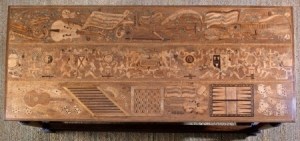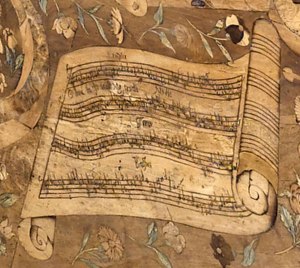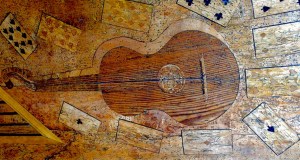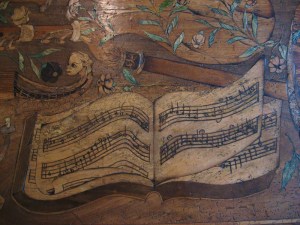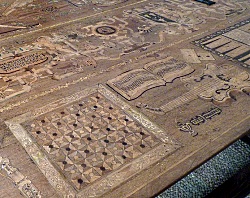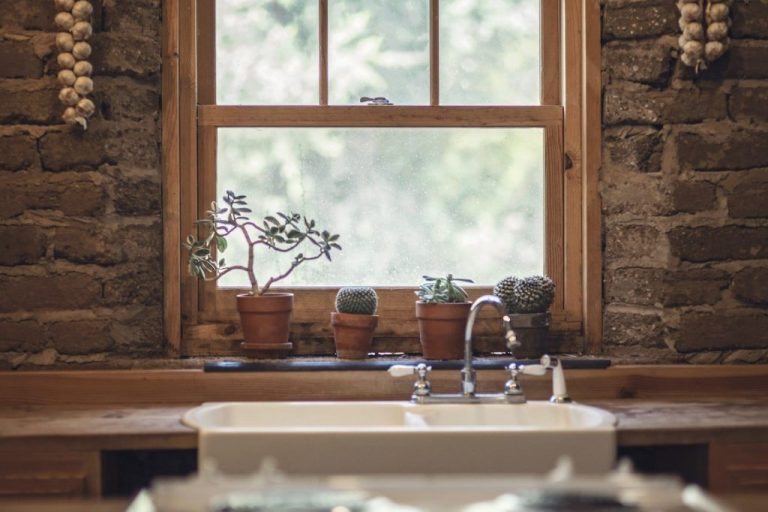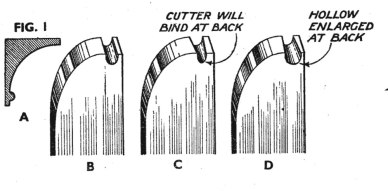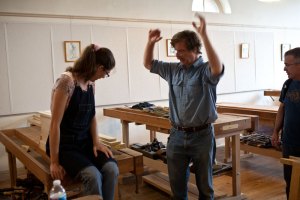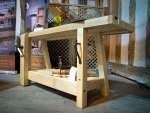Two Households and a Pair of Star-cross’d Tables –
Two massive tables bookending the first half of the 16th century and that is where the similarities end. One has seen hard use and is scarred, the other is fun and frivolous. One mirrors the poor choices made by the estate and the other is a celebration of wealth and multiple marriages.
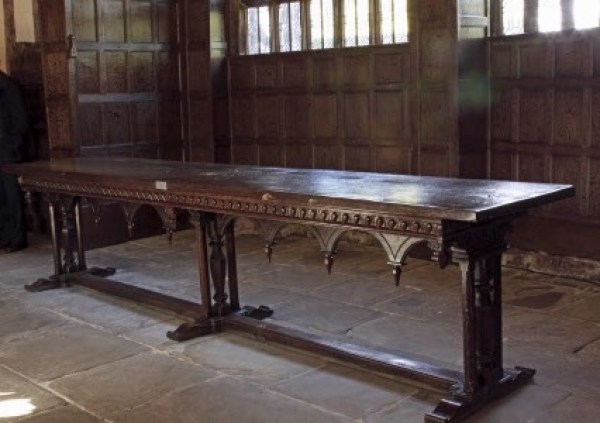
The Brute
The top of the table is original and was listed in the estate inventory of 1597. However, the frame is an 18th or 19th century replacement. The National Trust description of the frame is, “a round arcade with bosses below the spandrels. The top is mounted on three supports with a single stretcher running lengthways (appearing to be a later addition). The top of the frame has six pendant bosses at regular intervals carved with Ionic capitals.”
Little Moreton House is a half-timbered Tudor gem and has the distinction of being one of the most crooked houses in England. The house was in the same family for 450 years with additions made by successive generations. An ill-considered addition of an upper-story gallery put too much weight on the lower stories causing bending and warping. The table top did not fare much better, starting with the wood selection.
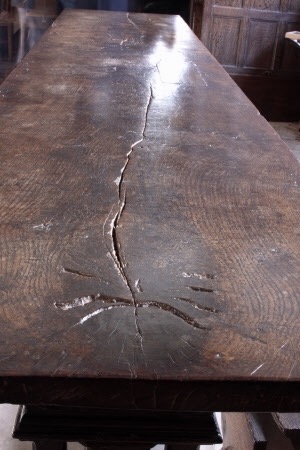
My consultation with a well-known “person of knowledge” associated with this blog revealed two things: the top board includes pith, a knot or both. The long crack indicates a “boxed heart” where some of the pith is part of the board. The radial crack seen in the foreground could be from a knot.
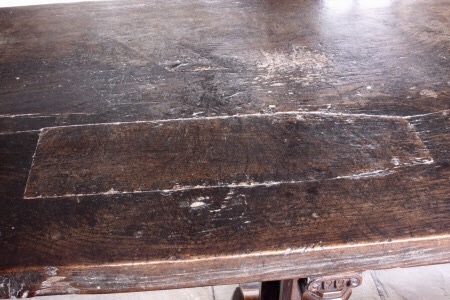
This table top lived a hard life with at least two repairs. Although the National Trust did not provide dimensions (there is an effort underway to provide more information on the thousands of pieces in their registry) I estimate the length to be 8 to 10 feet. In the language of the day this table top would be, “that whyche ys nedefoulle and nesesary.”
The Angel
At the same time Bess of Hardwick was to marry George Talbot, Earl of Shrewsbury, her son and daughter from a previous marriage were also marrying the children of Shrewsbury. She ordered a table to include the arms of Hardwick, Shrewsbury and Cavendish (the previous husband from whence her two children came) and designs for entertainments. By the way, it was 1568 and this was Bess’ fourth marriage.

This is the Aeglentyne, or Eglantine Table. The National Trust description: “Oak table with inlaid walnut rectangular top. Four conical legs, tapered from top, also inlaid, as is frieze and stretchers with moulded edges. Legs have carved capitals with egg and dart moulding above a gadrooned ring. Plinth foot is squared. Inside of stretchers painted strapwork pattern. Outside diamond and oval pattern. Frieze inlay has metopes and drops with roundels between. Top inlaid with musical instruments, etc.”
Aeglentyne is an old name for the sweet briar rose (Rosa eglanteria), is mentioned in many poems of the 16th century and is included in a short rhyme in a cartouche at the center of the table.

“The redolent smle/of aeglentyne./We stagges exauet/to the Deveyne.” The cartouche is surrounded with animals from heraldry and the joined arms of the three families involved in the three weddings. The remainder of the table has glorious inlays of flowers, musical instruments, sheet music, board games and playing cards.
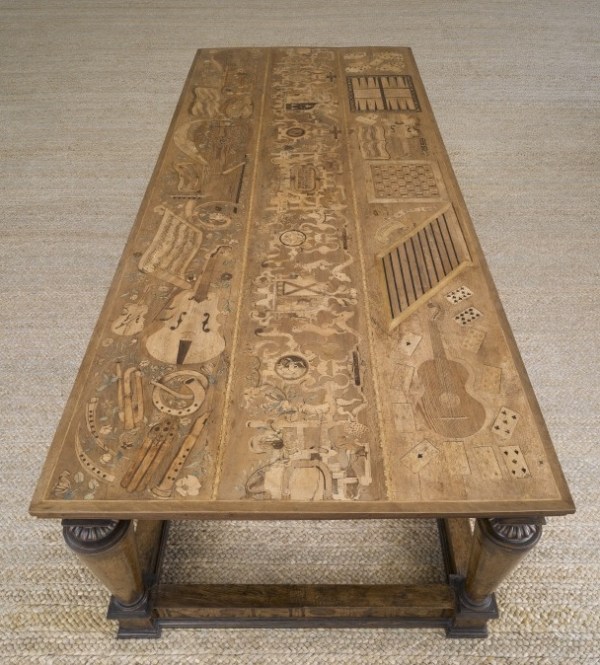
Among the musical instruments there at least five stringed instruments, maybe a sackbut, possibly a cornemuse and two or three pages of music. This table can accomodate them all as it is 90 cm high, 302 cm long and 129 cm wide (35.4″ h, 9’11” l, 50.8″ w).
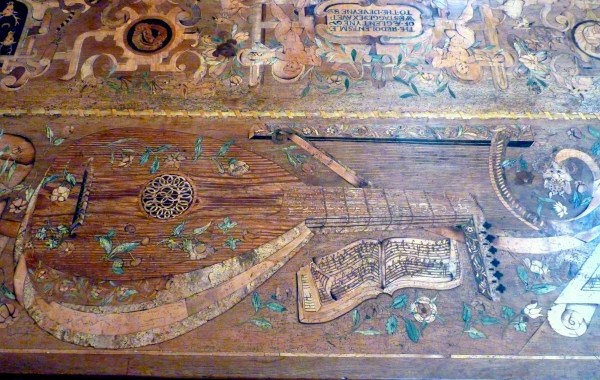
Playing cards are arranged as though the players just stepped away from the table. There is also a choice of three board games.

After the Earl of Shewsbury died Bess Harwick began building Hardwick Hall to replace the rundown Old Hall. The Aeglentyne table stands today in Hardwick Hall, a noted Elizabethan estate. In the inventory of 1601 it is believed the table was listed only as, “an inlayde table in the window.”
In these two tables we see one well used, but ravaged by poor wood selection and an awful frame replacement. This could very well be a piece that through time was removed from use by the family to use “below stairs.” On the other hand, the Aeglentyne table is an example of refined and careful wood selection, and an expression of pure vanity and indulgence for a women increasing her (and her children’s) wealth through another marriage.
In the spring of 2013 Les Canards Chantants sang some of the music from the table. You can watch and hear their visit in a very short video here.
In the gallery below are a few more photos of the Aeglentyne.
–Suzanne Ellison
